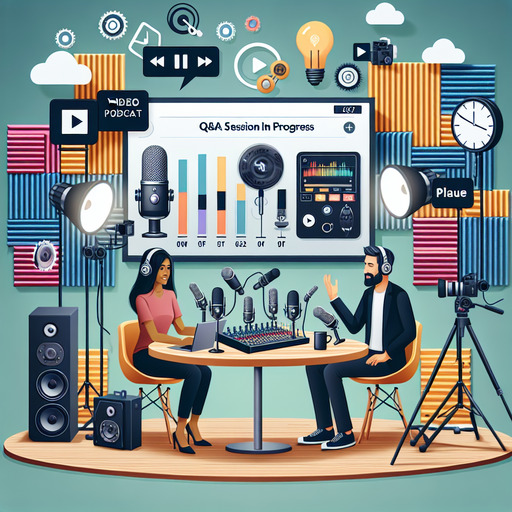
-
Table of Contents
Discover the essential gear for your video podcasting journey! Learn what you really need to create high-quality content. Get started now!
Introduction
Video podcasting has surged in popularity, offering creators a dynamic way to engage audiences through both visual and auditory content. To produce high-quality video podcasts, it’s essential to invest in the right equipment. This guide will cover the fundamental tools you need, including cameras, microphones, lighting, and editing software, to ensure your video podcast stands out. Whether you’re a beginner or looking to upgrade your setup, understanding these key components will help you create professional and captivating content.
Essential Video Podcasting Equipment: What You Really Need for Professional Podcast Video Production
When venturing into the realm of video podcasting, the right equipment can make a significant difference in the quality of your production. To achieve a professional look and sound, it is essential to invest in the right tools. First and foremost, a high-quality camera is indispensable. While many podcasters start with their smartphone cameras, upgrading to a DSLR or mirrorless camera can dramatically enhance the visual appeal of your podcast. These cameras offer superior image quality, better low-light performance, and interchangeable lenses, allowing for greater creative flexibility.
In addition to a good camera, proper lighting is crucial. Natural light can be unpredictable and inconsistent, so investing in a reliable lighting setup is advisable. Softbox lights, ring lights, or LED panels can provide consistent and flattering illumination, reducing harsh shadows and ensuring that your video looks professional. Positioning your lights correctly, typically at a 45-degree angle from your subject, can further enhance the visual quality.
Equally important is the audio quality of your podcast. Poor audio can detract from even the most visually stunning video. A high-quality microphone is essential for capturing clear and crisp sound. USB microphones are a popular choice for beginners due to their ease of use and affordability. However, for those seeking superior audio quality, XLR microphones paired with an audio interface offer greater control and fidelity. Additionally, using a pop filter can help minimize plosive sounds, and a shock mount can reduce vibrations and handling noise.
To ensure that your video and audio are in sync, a reliable recording device is necessary. While many cameras have built-in recording capabilities, using an external recorder can provide higher quality and more control over your recordings. External recorders often come with additional features such as multiple audio inputs, higher bit rates, and better preamps, which can significantly enhance the overall production quality.
Moreover, a sturdy tripod is essential for keeping your camera steady and ensuring smooth, professional-looking footage. Tripods come in various sizes and price ranges, so it is important to choose one that suits your specific needs. For added flexibility, consider a tripod with a fluid head, which allows for smooth panning and tilting movements.
In the realm of video podcasting, editing software is another critical component. Post-production is where you can refine your content, add effects, and ensure that your video and audio are perfectly synchronized. There are numerous editing software options available, ranging from free programs like DaVinci Resolve to professional-grade software like Adobe Premiere Pro. The choice of software will depend on your budget and the complexity of your editing needs.
Furthermore, a reliable computer with sufficient processing power and storage is necessary to handle the demands of video editing. High-resolution video files can be large and require significant computational resources to edit smoothly. Investing in a computer with a fast processor, ample RAM, and a dedicated graphics card can save you time and frustration during the editing process.
Lastly, consider the importance of a good backdrop or set design. A cluttered or distracting background can detract from your content. Whether you opt for a simple, clean backdrop or a more elaborate set design, ensuring that your background complements your podcast’s theme and style is essential.
In conclusion, while the initial investment in video podcasting equipment can be substantial, the right tools can significantly enhance the quality of your production. By prioritizing high-quality cameras, lighting, audio equipment, recording devices, tripods, editing software, and set design, you can create professional and engaging video podcasts that captivate your audience.
Q&A
1. **What essential equipment do you need for video podcasting?**
– **Camera**: A high-quality DSLR, mirrorless camera, or a good webcam.
– **Microphone**: A USB or XLR microphone for clear audio.
– **Lighting**: Softbox lights or ring lights to ensure proper illumination.
– **Tripod**: To keep the camera steady.
– **Audio Interface**: If using XLR microphones, an audio interface is necessary.
– **Headphones**: For monitoring audio quality.
– **Computer**: With sufficient processing power for recording and editing.
– **Recording Software**: Such as OBS Studio, Adobe Premiere Pro, or Final Cut Pro.
– **Backdrop**: A clean, professional background or green screen.
– **Cables and Accessories**: Necessary connectors, mounts, and adapters.